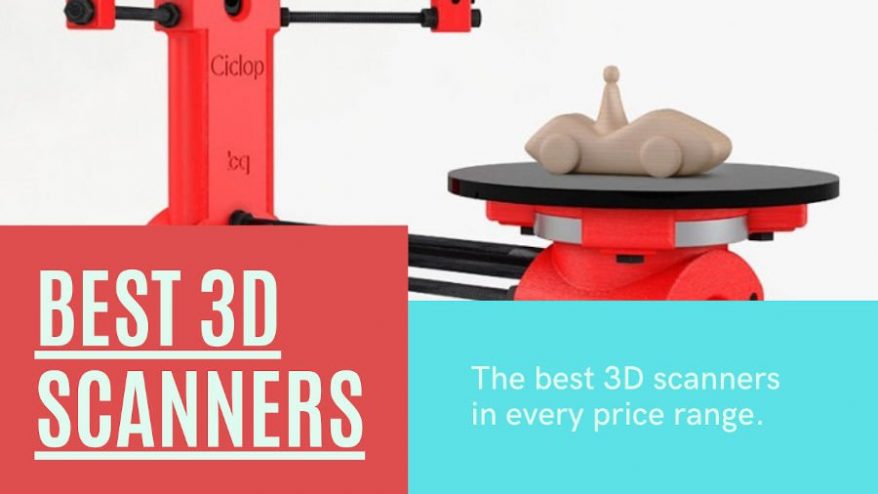
3D scanners are changing how we make, design, and see the world. By scanning nearby objects, people and almost anything else, these scanners create entire 3D digitized models of physical objects in just seconds.
Sometimes called 3D laser scanners, 3D model scanners or 3D object scanners, 3D scanners are integral for custom 3D printing and other fun home 3D scanner uses, for saving historical artifacts as digital models, dentistry – and so much more.
What’s more, you can now pick up powerful low-cost 3D scanners for just a few hundred dollars, and if you’re content with low-quality basic scans, you can even use your phone!
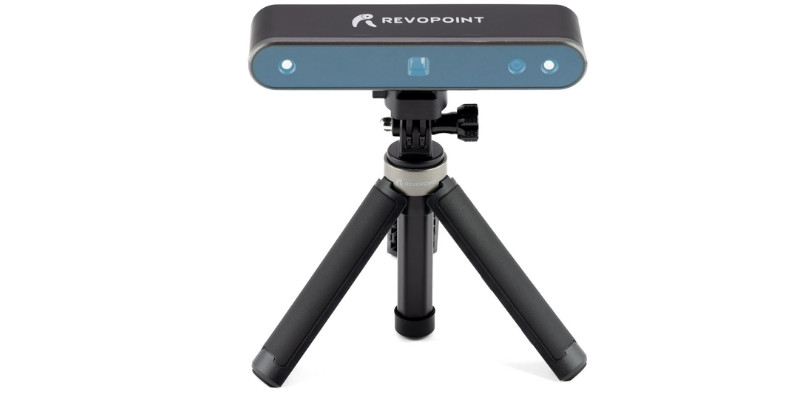
Revopoint POP 2
Versatile and portable with handheld & stationary options and color scanning
Up to 0.05mm accuracy on a small scanner that costs under $1000
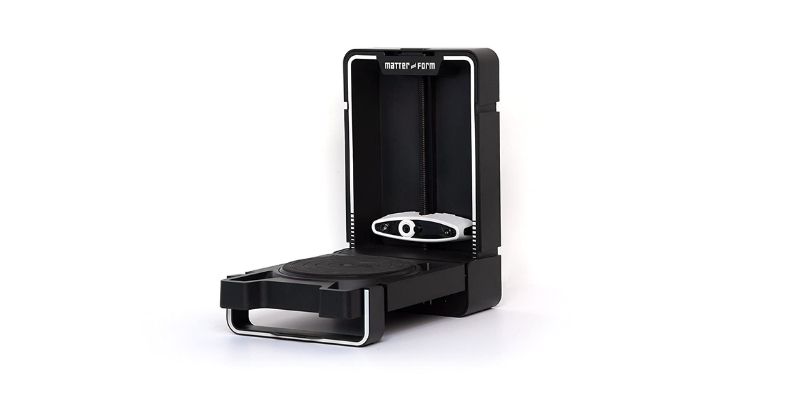
Matter & Form V2
Accurate 0.1mm scans
Powerful stationary scanner for 25x18cm objects
Comes with specialized software
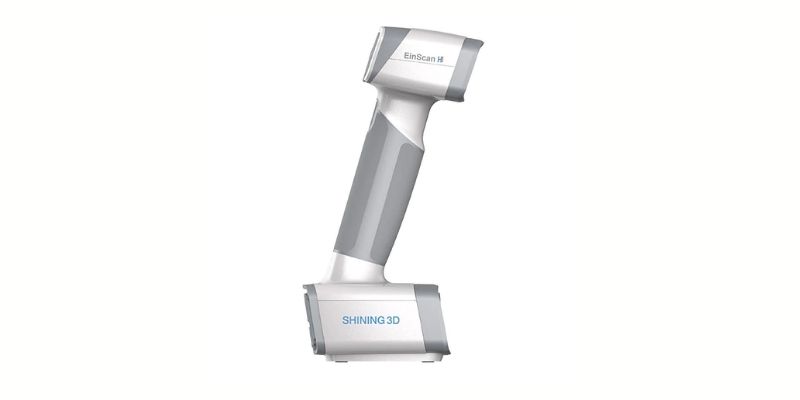
Shining 3D EinScan H
0.05mm scan accuracy and 0.25mm resolution with 1.2 million points/s
Infrared scan sensors make scanning darker colors easier
To rank the best 3D scanners, we considered:
- Accuracy and resolution
- Scan area (benefiting handheld scanners that can scan larger areas)
- Scan speed
- Ease of use
- Price-performance ratio
- Versatility
We also separated our 3D scanner reviews into three main price categories:
The Best 3D Scanners for All Prices Ranges
| 3D Scanner Brand & Name | Type of 3D Scanner | Price | Where to buy and where has the best price |
|---|---|---|---|
| Revopoint 3D POP 2 | Structured Light | $699 | Revopoint 3D here |
| Creality CR-Scan 01 | Structured Light | $700 | Creality Store here |
| SOL 3D scanner by Scan Dimension | Desktop 3D Scanner | $699 | Amazon here |
| BQ Ciclop | Laser Triangulation (DIY) | Depends if pre-assembled or DIY | Amazon here |
| Matter & Form V2 | Desktop 3D Scanner | $749 | Amazon here |
| Shining 3D EinScan SE | Desktop 3D Scanner | $1,399 | Amazon here |
| EinScan H | Handheld | $4,999 | Dynamism Store here |
| Shining 3D EinScan Pro 2X Plus | Handheld 3D Scanner | $6,800-$8,300 | Amazon here |
| Scantech iReal2E | Handheld 3D Scanner | $3,980 | Scantech Site |
| Artec EVA | Industrial 3D Scanner | $19,800 | |
| Scantech SIMSCAN | Portable 3D scanner | Contact for price | Scantech site |
| Scantech KSCAN | Handheld 3D Scanner | Contact for price | Scantech site |
But before we get into the best scanners, here’s a quick intro to how 3D scanners work:
How Does a 3D scanner Work?
3D scanners work by creating point clouds based on images taken of a solid surface or object — basically huge numbers of data points that denote where an object is — to create a 3D model of the scanned part. Millions of individual data points make up the model, which you can then export as an STL, OBJ or other file type and import to CAD software, or 3D print via a slicer.
3D scanning includes several different technologies, such as Structured Light scanning and Laser Triangulation, while some are stationary and some are handheld.
The Best 3D Scanners 2022: Budget Picks
3DSourced is reader-supported. When you buy through links on our site, we may earn an affiliate commission. Learn more
Revopoint POP 2
- Price: $699 — Available at Revopoint Official store here
- Precision: 0.05 mm
- Scan Speed: 10 FPS
- Minimum Scan Volume: 20 x 20 x 20 mm
- Single Capture Range: 210 x 130 mm
- Working Distance: 150 – 400 mm
- Point Cloud Distance / Single-Frame Accuracy: 0.15 mm
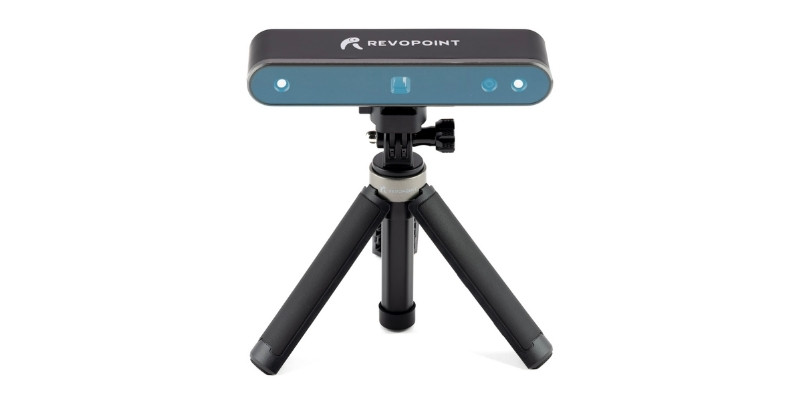
Pros
Versatile scanning options.
Increased precision of up to 0.05mm.
Accurately scans faces and bodies.
Suitable for scanning color images.
Cons
Changing settings may be required when scanning faces to prevent noise distortion.
Automatically meshing clouds when face scanning can create distorted scans.
We were extremely impressed with the Revopoint POP 2 when we tested it recently, and overall we feel it’s the most versatile and powerful 3D scanner under $1,000. While there are some great stationary scanners like the Matter and Form V2, the Revopoint’s usability for turnstile stationary scanning, color scanning, as well as handheld scanning for faces and bodies makes it the ideal multi-use 3D scanner.

The POP 2 notably upgrades on the original POP, with precision increased from around 0.3mm to up to 0.05mm (our tests found it to be in the 0.07mm range, which is still very impressive), a slightly faster scan speed of 10fps vs 8, and a slightly smaller minimum scan volume of 20mm³ vs the original POP’s 30mm³.

It scanned color images well when we tested it on some kids toys and a multi-color Rubik’s cube, and scanned faces accurately (but you need to change some settings around to prevent any noise distorting your scanned faces).

Overall, we highly recommend it as one of the best scanners in its price range – standard scanning, face scanning, color, or entire body scanning, it’s good for all uses.

Compare the scanners: Revopoint POP vs POP 2
Creality CR-Scan 01
- Price: $650-$700 — Available at Creality Official store here / Amazon here
- Accuracy: 0.1 mm
- Resolution: 0.5 mm
- Max Scan Volume: 536 x 378 mm
- Technology: Structured light
- Speed/Frame Rate: 10 FPS
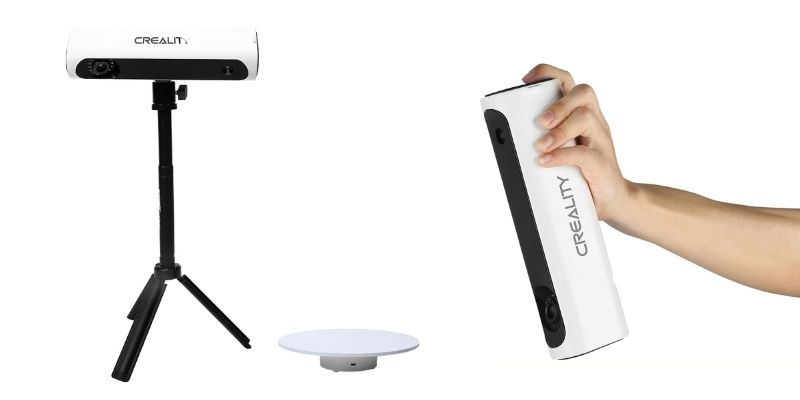
Pros
Budget-Freindly.
Color mapping allows for accurate color reproduction of the scanned object.
Good distance and scanning area, making it ideal for large objects.
Offers robust post-processing software.
Cons
Always needs to be connected to a cable that is only 1.5m long.
You will need to upgrade it for much more detailed projects.
With a cemented reputation for offering some of the best budget 3D printers on the market today, Creality aims to do very much the same with the affordable Creality CR-Scan 01 3D scanner. It employs structured light technology to feel out the shape, size, and texture of a 3D object to generate a digital reproduction.
Creality has fitted the CR-Scan 01 with both a handheld mode and a stationary turntable mode, each with their own set of advantages:
- In handheld mode, the scanner quickly works through larger objects, offering flexibility and on-the-fly capture.
- Switch to turntable mode, and the tripod-mounted Creality CR-Scan 01 creates an automated, higher-accuracy 360° scan as the object rotates on the turntable.
Both modes offer accuracy of 0.1 mm, a resolution of 0.5 mm, 24-bit high-fidelity color mapping, and marker-free scanning thanks to a clever alignment algorithm.
The Creality CR-Scan 01 also makes smart adjustments based on light levels, making it suitable for low-light environments. These are all excellent features for the asking price and sufficient for most hobbyist scanning needs, although somewhat lacking for high-precision scanning.
However, where the Creality CR-Scan 01 shines is a distance of 400-900 mm, which outclasses most budget 3D scanners, with a scanning area of 536 x 378 mm. In practice, you can scan medium to large objects further away with a larger frame size, which speeds up the scanning process considerably.
Finally, the bundled Creality’s CR Studio is a robust post-processing suite with all manner of editing, repair, color, and smoothing tools to polish off digital scans ready for 3D printing or other applications. It’s a solid competitor to the Revopoint scanners.
SOL 3D Scanner by Scan Dimension — Perfect desktop 3D scanner
- 3D scanner price: $699 — Available on Amazon here
- Accuracy: up to 0.1 mm
- Scan volume: up to 170 x 170 mm
- Scan speed: 10 min in Turbo mode, 20 min normally
Pros
Portable: Weighing in at just 7 pounds, making it easy to carry around.
Two modes: Near mode and Far mode, allow users to scan objects of different sizes.
Easy to use software.
Can be used for both business and home purposes.
Cons
Has trouble scanning white and black objects.
SOL is a desktop laser scanner designed for scanning small yet detailed items, with good accuracy for the price.
The actual scanner itself weighs just 7 pounds, and can scan objects that weigh up to 2kg. This light weight makes it a perfect portable 3D scanner if you’re on the move.
It has two different modes depending on what you’re scanning:
- Near mode: for scanning objects of up to 100 mm in diameter and 100 mm in height.
- Far mode: for scanning objects up to 170 mm in diameter and 170 mm in height.
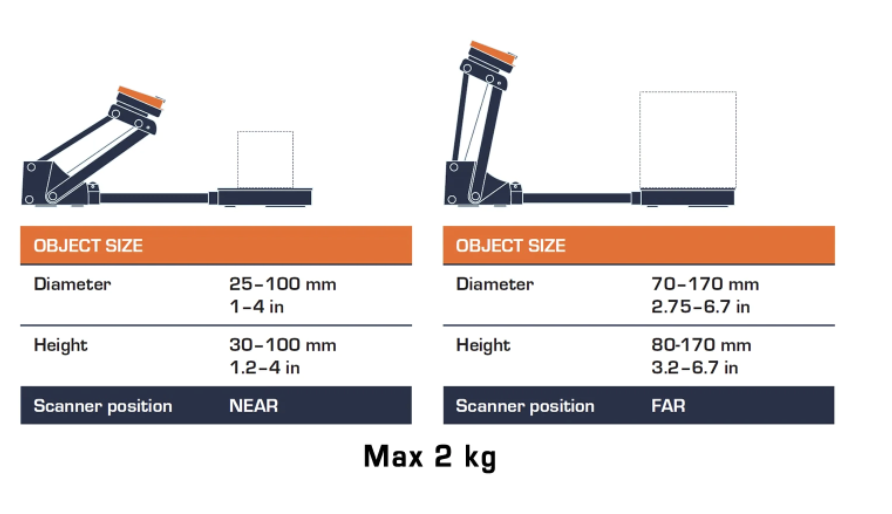
The SOL boasts an accuracy of around 0.1 mm, extremely good for the price range. You scan objects with their included SOL 3D software, and can then easily export your scans as OBJ or STL files and import them into a 3D slicer for 3D printing.
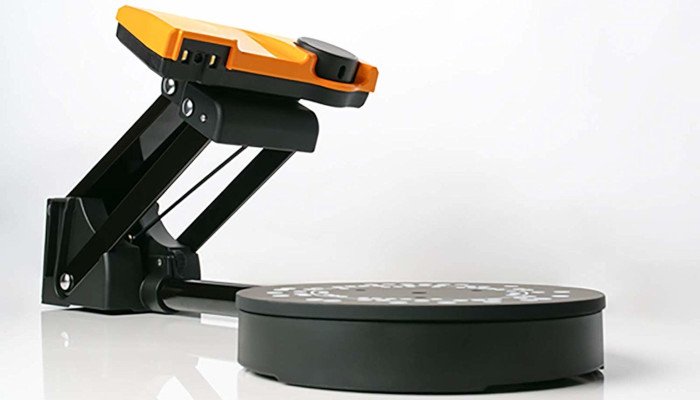
Danish company Scan Dimension promotes this impressive 3D visualizer not only for makers or hobbyists, but also for entrepreneurs. They sell the SOL 3D scanning camera as a way for entrepreneurs to show their products off with a 360-degree view, with easy ways to share these scans on Facebook.
Additionally, Scan Dimension say the scanner is also perfectly suited for education, for teaching students STEM education through scanning and editing structures.
Overall, it’s well suited as both a 3D scanner for businesses, as well as a home 3D scanner for hobbyists.
BQ Ciclop — Home-made 3D scanner for technical makers
- Price: Depends if buying or DIY — Available on Amazon here
- Resolution: 0.5 mm
- Scan time: 2-8 mins
- Maximum scan volume: 200 x 200 x 205 mm
- 3D scanning technology: Laser Triangulation
Pros
The kit can be modified according to individual preferences.
Laser triangulation technology is used, allowing for precise and accurate scans.
Easy to build.
Cons
The scanner comes in a DIY kit means it will take more time to set up.
Unlike many scanners, this DIY 3D scanner is open source, with all the files hosted on Thingiverse for you to download and print. The Ciclop has proven popular, with tens of thousands of downloads on Thingiverse alone.
BQ provides all of the information, software, and electronics for this 3D scanner kit which you can modify for yourself on their website, and other variations have been brought to market offering tweaks and improvements on the opensource design, such as CowTech’s version.
Read more: the other variations of Ciclop feature in our DIY 3D scanners review
The BQ Ciclop 3D scanner uses laser triangulation technology, and can scan objects in a few minutes. Moreover, the simple and well-written instructions allow anyone, no matter their skill level, to build the scanner in under an hour. BQ host downloads for all the drivers for the camera and firmware that you need, and developed a specialized 3D scanner app called Horus for scanning on your Ciclop.
It’s simple but effective. It’s made from ten 3D printed parts (download .STL files from Thingiverse), a threaded rod, a Logitech C270 webcam, two line lasers, and a turntable platform with a stepper motor, though you can edit and modify it as you wish.
The BQ Ciclop scans a volume of 250 x 205 mm and has a resolution of up to 0.5mm. It can be connected via USB or Bluetooth, making it a versatile and affordable low-cost 3D scanner for beginners.
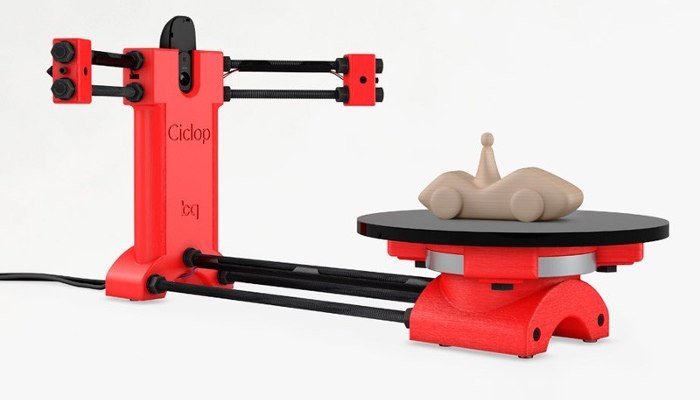
Matter and Form V2 MFS1V2 — Portable 3D scanners under $1,000
- 3D scanner cost: $749 — Available on Amazon here / Available on Matterhackers here
- Scan volume: 250 x 180 mm
- Accuracy: within 0.1 mm
- Scan speed: up to 65 seconds
Pros
Easy to use and straightforward to operate.
Fast scanning with the quickscan feature.
Designed to fold up, making it very portable.
Cons
Has trouble picking up very fine detail.
Lighting can be tough to get right.
The Matter and Form V2 is an updated version of the original desktop 3D scanner made by the Canadian tech startup. This low-cost 3D scanner uses 2 lasers and an HD-CMOS sensor to produce high-resolution, full-color 3D scans.
The scanner has an accuracy of up to around 0.1mm, and is easily connectable to your computer through USB to transfer over your scans.
For editing scans, the Matter and Form scanner comes with specialized Mfstudio, and +Quickscan which boosts scan speed to up to 65 seconds. You can then export the STL file and print them with your 3D printer.
The 3D scanner can scan objects in sizes up to 25 cm tall and 18 cm in diameter. It is compatible with every major OS, so Mac users needn’t worry. What we like most however is that it folds up, making it a perfect portable 3D scanner.
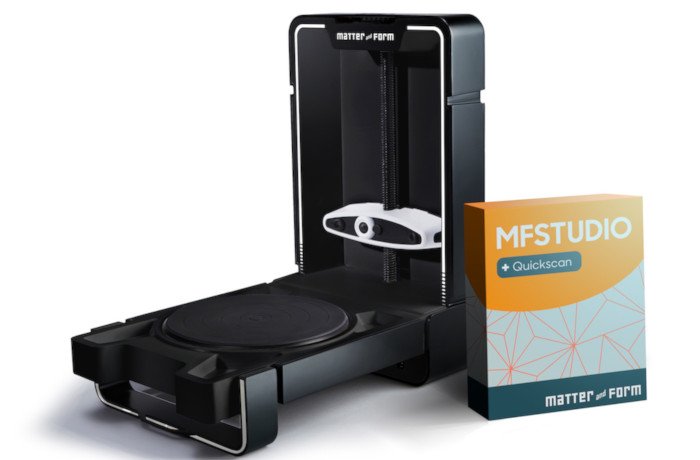
Medium Priced 3D Scanners: $1,000 to $10,000
Shining 3D EinScan SE — Best 3D scanner under $2000
- Price: $1,199 — Available on Amazon here / Dynamism here
- Scan accuracy: within 0.1 mm for single shots
- Scan range: single scan = 200 x 150 mm, maximum scan range = 700 x 700 mm
- Scan speed: a single shot is under 8 seconds
Pros
Highly accurate: Single shot accuracy is within 0.1mm.
Fast scanning with its 8-second scanning time and 2-minute 360-degree automatic scan mode.
Cons
Difficult to scan in brightly light areas.
Shining 3D have made a name for themselves in the medium-range 3D scanning sector, with cheaper options such as the EinScan-SE as well as more expensive scanners like the EinScan Pro 2X Plus.
The EinScan SE is one of the best 3D object scanners in its price range. It scans in around 8 seconds (versus 4 seconds for the EinScan SP) and can complete a whole 360-degree scan in its Automatic Scan mode in around 2 minutes.
It can scan objects up to around 200 mm wide and 150 mm tall, with a single shot accuracy of within 0.1 mm — making it one of the best 3D scanners under $2000. For a fixed scan without the turntable, max scan volume increases up to 700 x 700 mm.
Overall, this 3D model scanner is accurate, reliable, and makes it easy to quickly scan stationary objects and 3D print them with ease. The EinScan SP — described in more detail further in this guide — is more precise, but costs more. Therefore, it’s a matter of your budget and how important this additional quality is for you personally.
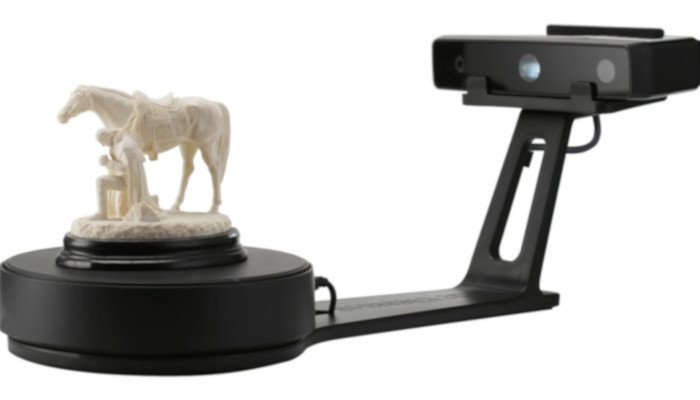
EinScan H
- Price: $5,000 — Available at Dynamism here
- Accuracy: 0.05 mm
- Resolution: 0.25 mm
- Max Scan Volume: 780 x 900 mm
- Technology: Hybrid structured light LED and infrared
- Speed/Frame Rate: 1,200,000 points/s, 20FPS
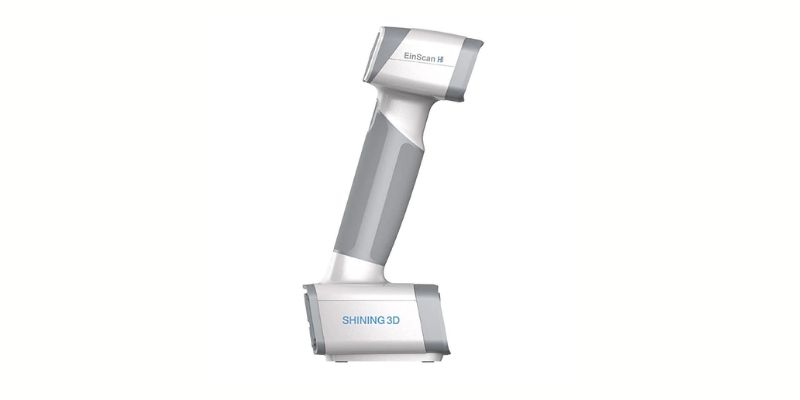
Pros
Dual light sources make it useful for capturing the detail and intricacies of darker colors.
With a generous 420×440 mm single capture range, the EinScan H can scan large objects efficiently.
Suitable for variety of professions such as healthcare, art, and forensic science.
Cons
High cost despite being affordable by its great standards.
The EinScan H is a professional-grade handheld 3D scanner that combines speed, accurate reproduction, and ease of use with a particular emphasis on bringing usually tricky 3D objects to digital life.
The EinScan H combines two light sources – structured LED and invisible infrared – to cover a wide range of 3D objects, modes, and applications.
For example, the infrared light excels at capturing the detail and intricacies of darker colors, notably those of human hair and general facial scanning – with dark hair the bane of any experienced face 3D scanner.
An added benefit of the invisible light is more comfortable scanning for the subject and no on-face glare to complicate the scanning process.
Manufacturer Shining 3D has also gone to considerable lengths to merge impressive accuracy and resolution along with fast scanning speeds. The EinScan H pushes a resolution of 0.25 mm with accuracy as low as 0.05 mm, all at roughly 1,200,000 points/s at 20FPS.
The scanner also features authentic, full-color reproduction with solid texture mapping that translates to systematically excellent scan quality.
According to Shining 3D, it’s possible to scan an entire human body in fine detail in a matter of minutes. A generous 420 x 440 mm single capture range helps keep things speedy even when scanning large objects aided by an optimized alignment algorithm to keep scans crisp and precise.
Although priced at $5000, the EinScan H falls roughly in the affordable range and is a versatile tool suited for healthcare, art, forensic science, and other professional 3D modeling applications.
Scantech iReal 2E Color 3D Scanner — A complete 3D scanning solution
- Price: $3,980
- Scanning area: Up to 850 mm x 800 mm
- Accuracy: Up to 0.100 mm
Pros
User friendly and requires no special skills or training.
High-quality scanning with its advanced red VCSEL structured light technology.
One of the fastest handheld 3D scanners available.
Cons
There are more accurate 3D scanners out there for reverse engineering purposes or meteorology.
iReal 2E is a professional handheld color 3D scanner manufactured by Scantech. The company specializes in developing, manufacturing, and selling intelligent visual inspection equipment and sells an entire range of 3D scanners for various applications and sectors.
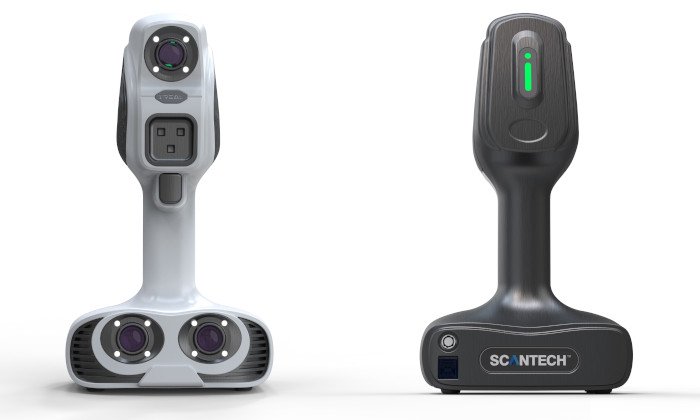
The iReal 2E uses red VCSEL structured light technology to offer you a simple and safe 3D scanning experience, eliminating the issues of dazzling lights and difficulties in hair 3D scanning.
Without attaching markers, a quick and accurate texture and geometry scan can be achieved with a wide scanning area of 850 mm x 800 mm, 750 mm depth of field, 1.5 million measurements per second, and at 0.100 mm accuracy. Mixed alignment modes meet various scanning situations.
Shining 3D EinScan SP
- Price: $2,599 — Available on Amazon here / Dynamism here
- Scan range: single scan = 200 x 150 mm, max scan range = 1200mm³
- Accuracy: within 0.05 mm for single shots
- Speed: single shot speed of under 4 seconds
Pros
Can complete a scan In 4 seconds, half the time of its predecessors.
Fast full object scanning.
Competitive scan quality despite its lower cost.
Cons
A scanning spray is needed to scan dark and shiny areas.
While using auto-mode, it has a fairly restricted scan volume.
The second Shining 3D medium-range 3D scanner in our ranking, the EinScan SP is more accurate than the EinScan SE, with accuracy up to 0.05 mm rather than 0.1 mm, and scans single shots in half the time (4s vs 8s).
To save you time: double the price, double the accuracy — and half the scanning time.
The scanner uses white light scanning technologies to make very accurate scans of objects as small as 30 x 30 x 30 mm.
Full objects are typically scanned in less than a minute, and images in less than four seconds.
What’s more, despite its cheaper price, many buyers have reported that it can compete with scanners costing ten times as much for scan quality. It also comes with a tripod for stationary object 3D scanning.
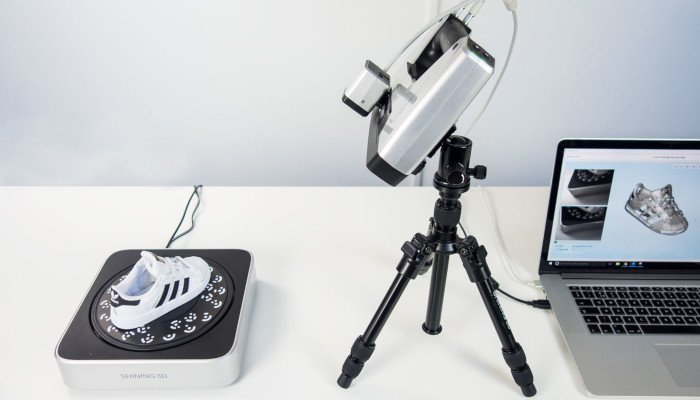
Shining 3D EinScan-Pro 2X Plus — One of the best 3D scanners around
- Price: $5,999 (full industrial pack costs extra) — Available on Amazon here / Dynamism here
- Accuracy: up to 0.04mm in fixed scan turntable mode
- Volumetric accuracy: 0.3mm/m
- Speed: fixed scan single shot in under 0.5 seconds / up to 30fps with handheld use
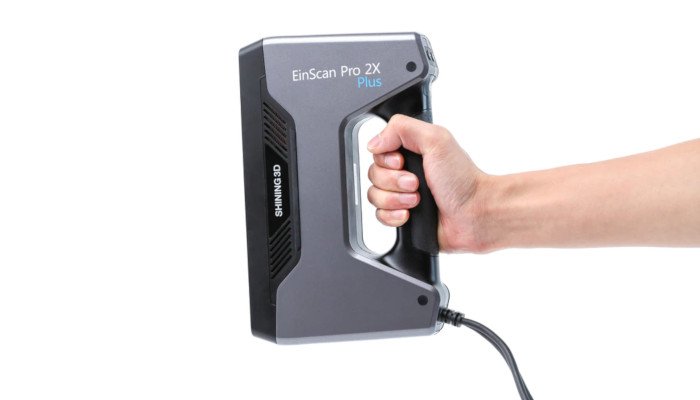
Pros
Can be used as a fixed or handheld.
Increased accuracy and scans faster as it uses white light 3D scanning technologies.
Highly accurate regardless of scan volume.
Cons
Meshing software can miss the mark from time to time.
The EinScan-Pro 2X Plus costs more than the EinScan SP and H, and can be used as a fixed or handheld 3D scanner to capture various-sized objects.
It uses white light 3D scanning technologies to increase accuracy and scan faster (sub 0.5-second single shot scans), creating high-quality scans in record time.
You can simply hold the scanner and point it towards the object or room you want to 3D scan, and instantly record crisp scans of your surroundings. Whereas lower-cost scanners limit you to desktop sizes, the Pro 2X Plus frees you to capture entire rooms.
You may want to 3D scan a car, your friend, or even turn it into a baby 3D scanner for a 3D memory of your child before it grows up!
You retain the accuracy however with the scan volume freedom, with accuracy up to 0.03mm for objects less than 4m away.
Industrial & Professional 3D Scanners: $10,000+
Artec EVA — Powerful handheld 3D scanner
- Price: $19,800
- Accuracy: up to 0.1 mm + 0.3mm/m
- Resolution: up to 0.2 mm
- Speed: captures up to 16fps in HD and full-color
- Working distance: 0.4m – 1m
Pros
High precision.
Uses structured light scanning technology, making it possible to scan objects other 3D scanners will find difficult.
Scans a wide range of objects.
Cons
Very expensive as it is a high-end 3D scanner.
Creating new innovative solutions in 3D technology since 2007, Artec 3D is a global leader in handheld 3D scanners. Their most popular scanner, the Eva, is a handheld, industrial 3D object scanner, and an excellent solution for medium-sized objects ranging from motorcycle wheels to car exhaust systems, human busts and facial close-ups.
Light, quick, and versatile, Artec Eva captures precise measurements in high resolution, while structured light scanning technology makes the scanner safe to use in any situation – even difficult to scan surfaces such as black or shiny surfaces are effectively captured by Eva.
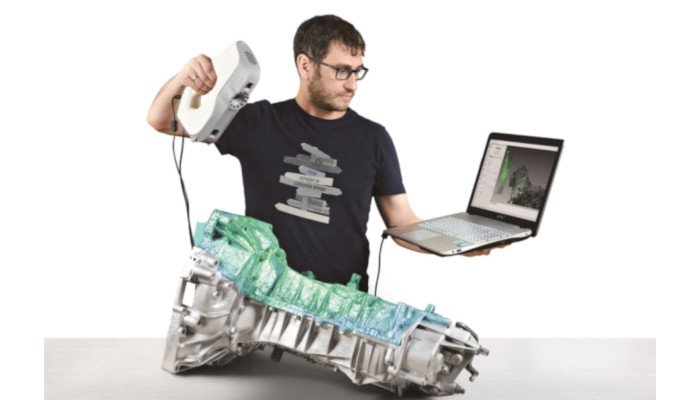
Ideal for use in industries including product design, heritage preservation, healthcare, and reverse engineering, this market leader can accurately scan full-color objects at a range of up to 100cm with color and texture, making it a great solution for fast and accurate 3D models.
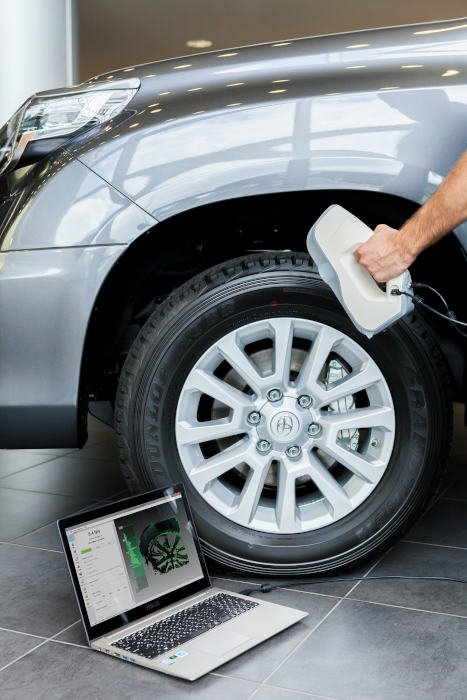
Scantech SIMSCAN — hand-sized portable 3D scanner
- Accuracy: up to 0.020 mm
- Resolution: up to 0.025 mm
- Scanning area: up to 410 x 400 mm
Pros
Designed for both beginners and professionals.
Lightweight.
Sturdy and durable.
Cons
The software could be more intuitive.
Scantech’s SIMSCAN consists of two sets of industrial black & white cameras, a laser projector with 30 laser lines, and a set of multifunctional buttons. Its high-quality components ensure fast and stable 3D scanning.
It features three scanning modes: ultra-fast scanning, hyperfine scanning, and deep hole scanning optimized for different scanning situations. With its intelligent auxiliary lights, it can even scan darkly lit objects.
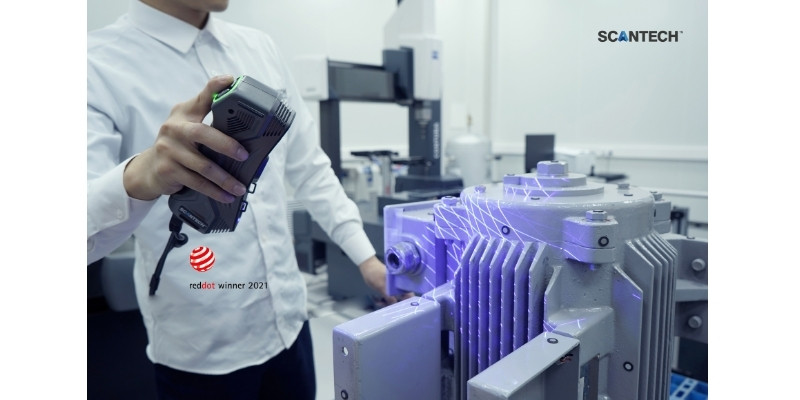
Powered by a robust algorithm, SIMSCAN’s measurement rate can be up to 2.02 million measurements/s with an accuracy of up to 0.020 mm. It has a field of view of up to 410 x 400 mm.
With a net weight of 570g, SIMSCAN can be among the top list of the most lightweight and portable 3D scanners in the market. It is designed for both beginners and professionals to conduct 3D scanning regardless of ambient conditions. Thanks to its compact size and portability, SIMSCAN enables on-site and efficient 3D scanning, and it suits well for scanning hard-to-reach areas.
Made from aerospace-grade aluminum-alloy, Scantech’s SIMSCAN scanner is sturdy and durable and performs well in heat dissipation. Its material ensures a prolonged use of the 3D scanner. With an anti-slip shell and a hand strap, you can orient this scanner in any way you choose to suit your 3D scanning needs.
Scantech KSCAN-Magic — industrial handheld 3D scanner
- Resolution: 0.010 mm
- Scanning rate: 1,350,000 measurements/second
- Scanning area: 1440 x 860 mm
Pros
Can scan massive objects, such as plane parts as well as intricate, small objects.
Features both infrared lasers and blue laser technologies, which allows it to accomplish a wide range of scanning functions.
Cons
The software will take time to get used to.
Esteemed 3D scanner company Scantech have announced the launch of their latest KSCAN 3D scanner, with 5 five different modes for all types of scanning. These include a large area scanning mode, fast scanning mode, photogrammetry, as well as a fine scanning mode. Featuring both infrared lasers and blue laser technologies allows the KSCAN-Magic to accomplish a wide range of scanning functions effectively.
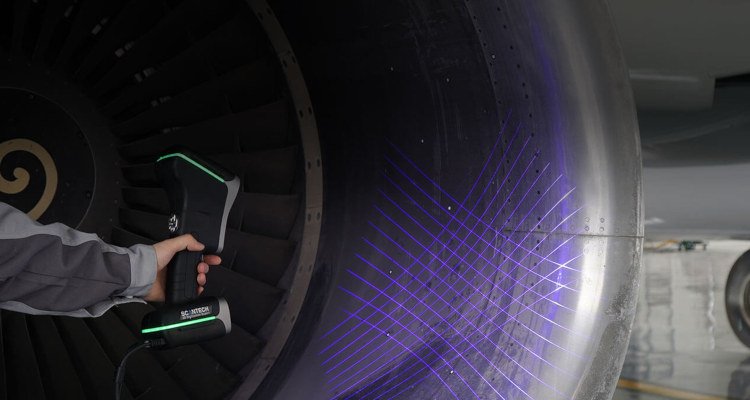
It scans accurately, quickly, can handle small and large objects, and is designed to accelerate time-to-market. The 41 equipped laser lines can handle an incredible 1.35 million measurements per second, creating detailed scans in record time.
If you are looking for leading-edge 3D solutions for your business, KSCAN definitely surpasses expectations with its resourcefulness and precision.
Are 3D Scanners Worth It?
3D scanners are almost always worth the investment, but to decide which is best for you, you’ll need to consider your budget, needs, and priorities. Keep an eye on scan resolution quality and accuracy, scan speed, and price to find a 3D scanner that’s worth it for you.
Buyer’s Guide – Things To Consider When Buying A 3D Scanner
Budget
Expect to pay anywhere from $400 to $200,000 for a 3D scanner. There are numerous options suited to all budgets dotted between those two extremes.
Entry-level hobby scanners suitable for 3D printing are available for less than $1,000, while more robust machines suited for light-professional scanning sell for around $5,000.
Should you want the cream of the crop scanners designed for the most-demanding industrial-level applications such as engineering, expect to pay more than $10,000.
Speed
When applied to 3D scanners, speed refers to the rate at which a machine captures or scans a 3D object. Consumers and most professional 3D scanners record speed in points per second or frames per second. The higher the count, the faster the scanner.
If you’re buying for a professional setting where productivity is critical, we recommend eyeing faster printers, which generally push points per second into the millions and frame rates around 20 FPS.
Resolution and Accuracy
Accuracy refers to how well the finished digital object matches its real-world counterpart. Accuracy pops up in specification sheets expressed in mm, which indicates to what degree the 3D scan sticks to the shape, size, features, etc., of the real-world object.
For a budget 3D scanner, 0.1-0.2 mm is a solid reference point, while much more expensive industry scanners can jump to as low as 0.009 mm on the most powerful devices.
Though similar to accuracy, the resolution refers to the smallest possible distance between points on a 3D scan. In layman’s terms, a higher resolution delivers finer details and more intricate, faithful features. You’ll find manufacturers refer to resolution in mm, a measure that balloons and shrinks based on the price of the 3D scanner.
Budget printers waver around 0.3-0.5 mm, while professional scanners can push resolutions as high as 0.1 mm.
Software and Connectivity
Connectivity refers to how a 3D scanner allows you to scan, export work, and interface with a PC or other device as well as the source of power. In most cases, USB is the standard, with some outliers offering Bluetooth.
If you’re looking for portability, consider handheld scanners that pair with Smartphones and power banks so you can quickly scan on the move.
Software tied to 3D scanners come in all shapes and sizes, from barebones scanning tools to advanced suites with all manner of post-processing touch-up options.
It goes without saying that software capabilities match the target audience of each scanner. Pay more for a professional scanner, and the software generally features a more robust set of tools.
Use Case
Entry-level 3D scanners are a good option for hobbyists looking to scan objects with 3D printing in mind. They are just about affordable and work well, although they lack the detail and speed of pricier models.
We recommend handheld 3D scanners for larger models. These grant a degree of freedom and movement to capture all the detail and breadth of bigger objects. A large scan area helps speed up scanning large objects, too.
For small fixed object scanning, where capturing all the rich details and texture of a model tops your list of requirements, look to stationary scanners, ideally with a turntable, tripod, and an optimized alignment algorithm.
3D Scanning to 3D Print
3D scanners are often used to create 3D printable models, with 3D scanner and 3D printer setups allowing you to replicate almost anything in front of you. Simply use the 3D scanning camera to create a digital model of your object, and then 3D print the scan.
Large objects can be scanned using handheld 3D scanners and moved around the object’s dimensions, and then sized down and 3D printed as a scale model. These 3D printer scanner combos offer almost limitless versatility.
3D Scanner Cost
Budget/entry-level
Thanks to efforts from companies like Creality and Revopoint, there’s a concerted effort to lower the cost of entry and boost accessibility to 3D scanners.
It’s now possible to buy a decent entry-level scanner for under $1,000, with ultra-budget options like the Phiz 3D scanner dropping as low as $400.
Even though the experience and features measure up to the price paid, budget 3D scanners offer everything needed to create decent quality scans suitable for hobbyist applications.
Read more: the top low-cost 3D scanners
Mid-range
Jumping up to the mid-range category, you’ll find 3D scanners priced anywhere from $1,000 to $10,000. These are generally professional-grade machines with a range of tech, modes, and excellent scan quality, striking a balance between functionality and price.
Top-range/Industrial
The top-shelf 3D scanners. Expect to pay upwards of $10,000 for industrial-grade devices. These are very much no-compromise options boasting the peak in accuracy, resolution, and scan speeds for industry applications such as scientific measurements, reverse engineering, demanding 3D visualization, architecture, and rapid prototyping.
3D Scanner Uses
Medical: custom orthopedics, wheelchair and mobility aids, prosthetics, plastic surgery implants, protective equipment, realistic dummies for training.
Dental: bespoke implant and crown design suited to specific patients.
Jewelry: bespoke designs, repairs, and easy duplication/replication of damaged family heirlooms or discontinued jewelry with sentimental value.
Hobbyist 3D Printing: scanning real-world objects for reproduction using a 3D printer. Miniatures, cosplay, household items and repairs, toys, and other functional parts.
Virtual Reality and Game Design: real-world object/landmark scanning for use in VR environments, and body scans to create realistic animations and in-game models.
Engineering: tolerance testing, quality control, data analysis, fully textured models, infrastructure building and monitoring.
Reverse Engineering and Repairs: automotive, aviation, naval repairs, and restoration of antique or discontinued vehicles.
Archeology and Conservation: heritage conservation of objects, artifacts, and skeletal remains.
Architecture: building scanning for surveying, design, and reverse engineering degraded exteriors for repair.
Forensics: digital replicas of crime scenes to capture evidence such as shoe prints, blood stains, bullet holes, and so on.
Types of 3D Scanners
The main types of 3D scanners include:
- Laser triangulation 3D scanners
- Structured light 3D scanning
- Photogrammetry
- LIDAR (time-of-flight)
- Metrology 3D scanners
- Intraoral 3D scanners for dentistry
- 3D body scanners
The two most-used technologies are structured light scanning and laser triangulation.
Structured Light Scanning
Structured light scanning is commonly used in handheld 3D scanners and involves projecting patterns of light at an object, with two cameras usually placed on either side of the projector to measure the light pattern from each side and calculate precise differences at every point in their field of view.
These cameras measure how the light deforms the light pattern, and by triangulating these multiple different reference points across different images of the scan from each camera view, you can accurately calculate the dimensions of the object.
As a result of its portability and accuracy, dental 3D scanners typically use structured light scanning to scan patients’ mouths and create dental implants and models. Beyond this however, architects and historians are using these types of 3D scanning to keep digital records of priceless historical monuments, and NASA even use it to map interplanetary terrains.
However, the use of projected light makes it very sensitive to the lighting conditions in the scanning environment, so working outside or in other similar environments can be difficult.
Laser triangulation
Laser scanning involves projecting a laser point on an object and then using sensors to capture the reflections to gather data on the object’s size. Based on the reflection angle from the laser’s sensors, the 3D scanner can create accurate textures and surfaces using trigonometric functions.
However, because it works off reflections it can be ineffective if scanning shiny or reflective surfaces, and won’t work well with anything transparent.
Structured light scanning is generally considered more accurate than laser scanning, with less noise in scans.
LiDAR 3D scanning and Time of Flight 3D scanning
Another form of 3D scanning, and the technology used in the latest iPhone 12 Pro, is LiDAR. Light Detection and Ranging involves shooting out light beams and calculating the object’s area — based on the speed of light — on the time taken to reflect back to the Lidar 3D scanner.
These are very similar to time-of-flight 3D scanners. These scanners shoot light pulses, calculating the time of flight for each pulse to create a 3D visualization — or point cloud. They’re commonly used to map terrains, measure real estate, and in architecture and construction.
Handheld 3D Scanners
Portable and versatile by design, handheld scanners allow you to efficiently and freely scan large objects, narrow spaces, or all the details of a human subject, for example.
Stationary 3D Scanners
Fixed scanners are a solid option if you plan to scan small objects and want the device to do most of the heavy lifting. They generally come with a stand or tripod and turntable. Automated scanning is also typically part of the deal here, with different modes of alignment to choose from.
3D Body Scanners
As the name implies, 3D body scanners are specifically designed to capture a full 3D scan of human bodies.
Towering machines, usually priced in the tens of thousands of dollars, 3D body scanners provide a fast and accurate 3D body scan for various applications, including health, fitness, animation, and more.
Read more: our feature story on 3D body scanners.




